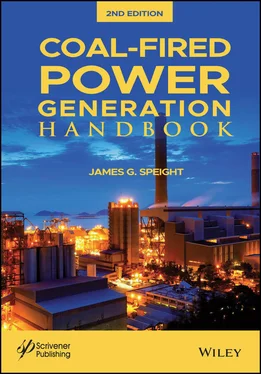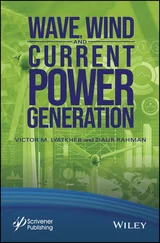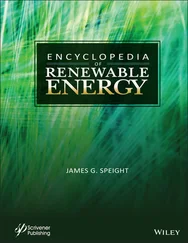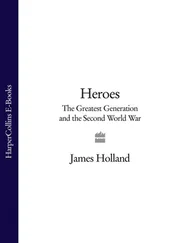The inertinite group comprises the macerals (i) fusinite, (ii) semi-fusinite, (iii) macrinite, (iv) micrinite, (v) inertodetrinite, and (vi) scleronite. Fusinite originates from the oxidation of cellular woody tissues and they occur in varying quantities in peat, lignite and bituminous coals. Semi-fusinite is characterized by high reflectance and they are derived from cellular woody tissue as well. Inertodetrinite is derived from oxidized cell-wall fragments and they have reflectance that varies within broad limits, their reflectance being slightly higher than that of vitrinite and liptinite. They can almost be classified as non-reactive during carbonization and produces less volatile products during pyrolsis.
2.5 Correlation of the Various Systems
The above illustrations indicate that, with the exception of perhaps the geological classification and the banded structure classification system, coal classification can be a complex operation. While only the major classification systems (especially those relevant to the North American and British scenarios) have been illustrated in detail, there are, nevertheless, other systems which have in the past been used in various other countries. Indeed, these other systems for the classification of coal may still find use in the countries of their origin. No attempt has been made to illustrate these systems in the present context, but they are certainly very worthy of mention as an indication of the nomenclature and terminology applied to coals of the various types.
Currently, the class numbers derived by the International System of Coal Classification can be approximated to the coal rank derived by the ASTM system (Figure 2.4) except that the International System uses an ash-free calorific value while the ASTM system employs a mineral free calorific value, which could cause a slight discrepancy in the assignments (Speight, 2013). The error lies in the fact that the weight of ash obtained by ignition is not the same as the weight of the mineral impurities: present in the original coal. The expulsion of water of hydration from the clay and/or shale impurities and the expulsion of carbon dioxide from the carbonates introduce errors that are too large to be ignored. Consequently a number of correction formulas have been derived which assume that the percentage of mineral matter in coal is numerically equal to 108% of the amount of ash produced plus 55% of the amount of the sulfur. This latter value takes into consideration the conversion of iron pyrites to iron & oxide during the ashing procedure.

Figure 2.4Comparison of class number (International System) with ASTM classification. Please note that (i) the parameters in the International System are on an ash-free Basis, ASTM parameters are mineral matter-free basis, mmf, (ii) there is no upper limit of calorific value for class 6 and high volatile bituminous coals (Speight, 2013).
Brown coals, like the hard coals, are also defined in: terms of their calorific value (see above) and were also recognized as potential fuels. The International system for the classification of brown coals is based on two inherent characteristics which indicate the value of brown coals as fuels: (i) the total moisture that is determined on an ash-free basis, often represented as af , and (ii) the yield of tar that is determined on a dry-ash-free basis, often represented as daf . Thus, the six classes of brown coal based on the ash-free, equilibrium moisture content are divided into groups according to the yield of tar on a dry, ash-free basis. This system indicates the value of the brown coals either as a fuel or as a chemical raw material with the notation that brown coals with a propensity to produce high yields of thermal tar have found more general use in the chemical industry rather than as a fuel.
Critics of the International System note that the parameters used (as well as in some other national systems) to define degree of coalification (rank), i.e., volatile matter and calorific value, are dependent on variable maceral composition. On the other hand, the parameters used in the International Classification to determine the agglutinating and coking properties of coals are competing parameters, instead of following a hierarchy. In order to circumvent such conflicts classification scheme has been proposed which is based on two primary parameters determined with microscopic techniques: (i) mean maximum reflectance of vitrinite, which is a good single measure of rank, and (ii) petrographic composition – vitrinite and exinite – as an indication of the type of coal ( Chapters 5, 6).
Vitrinite content – determined by vitrinite reflectance – is, in fact, an important rank parameter that is useful in the characterization of coking coal and may even be applicable to coal combustion during storage ( Chapter 4) and in a power plant Chapter 7). The analytical technique is sensitive, persistently changing throughout coalification and is particularly important for accurately measuring minor differences in those coals used for coke making, i.e., high volatile A bituminous through low volatile bituminous. The technique measures the amount of incident light reflected from a polished surface of the main component of coal, vitrinite. Vitrinite is that component of coal principally derived from woody tissues and, at least in coals from North America, represents the dominant component.
A third parameter is chosen to qualify the different classes of coal: volatile matter for anthracitic coals; dilatation for semi-anthracite and bituminous coals; and calorific value for subbituminous coal and lignite. The scheme is expressed by mean of a code number of four digits, which refers to the rank (first digit), type (second and third digits) and qualification (fourth digit) of coal (Uribe and Pérez, 1985).
Even though there have been serious, and successful, attempts to define coal by means of a variable series of classification systems, there is now, in the modern world, a potential lapse in the information. And that relates to the environmental issues. Other than comparing data (such as is provided by elemental analyses) (Speight, 2013, 2015), there is no other means by which the potential environmental liability of coal usage can be determined. Nor, for that matter, might there ever be; but such a possibility is always worthy of consideration as coal science and technology evolves and moves into the era of clean coal technology (Speight, 2013).
Table 2.10 Comparison of Various Coal Classification Systems.
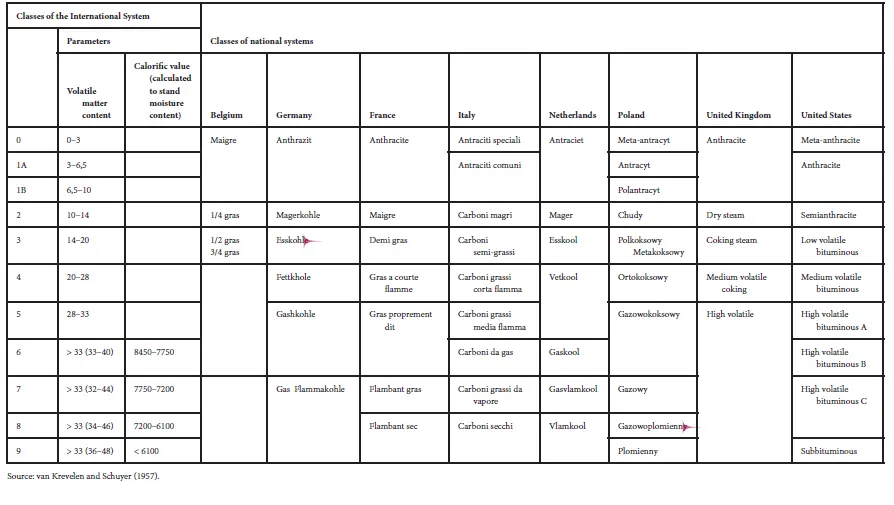
Finally, it is difficult (if not impossible) to treat coal classification and coal terminology as separate entities. Indeed, the terms applied to the various coals as a result of a particular classification system invariably displace some of the older and less specific names of the coals. Thus, because of the various systems which have originated in the coal-producing (as well as the coal-consuming) nations, several names may have evolved for one) particular type of coal ( Table 2.10).
Such a profusion of names can make cross-referencing very difficult and it is beneficial for the coal scientist to become as familiar as possible with the various terminologies that exist. The only means by which this problem could be alleviated would be the establishment of a truly international; system for the classification and nomenclature of coal.
In summary, all classification schemes have similar objectives. However, a classification system meant exclusively for combustion application (such as coal-fired power generation) does not exist and is unlikely to be developed with the present approaches. Many classification schemes are restricted to two or three coal (typically less than six properties) properties and so the picture of the suitability of coal for a power plant may not be complete. If too many properties are involved, the classification can become complicated (if not, confusing). In general, rank, calorific value, proximate and ultimate analyses, fuel and atomic ratios and petrography seem to be the most important variables for characterizing the behavior of coal during combustion. Such properties are highly interrelated. It may be possible to develop a classification system using all these properties and still achieve a reasonably simple grouping – to this end principal component analysis may offer a solution under certain conditions. However, the choice of the variables will be critical and the outcome is to determine if the methodology and the analysis can be repeated satisfactorily for other combinations of variables.
Читать дальше
